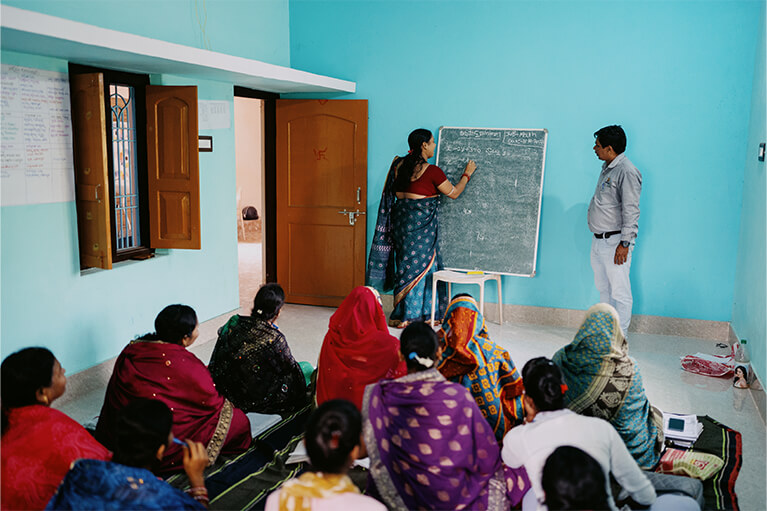The benefits of investing in continued education for women, in communities and countries have been well documented. According to UNICEF, girls who receive an education are less likely to marry young, more likely to lead healthy, productive lives; earning higher incomes and participating in decisions that most affect them. Sustainable Development Goal 4 lays strong emphasis on ensuring global equity and inclusivity in education by 2030. Year on year, in India, the proportion of 15-16-year-old girls not enrolled in school has continued to drop, standing at 7.9% in 2022 (ASER 2022).
The Second Chance program was conceptualised by Pratham to address the issue of women dropouts. Launched in 2013, the aim of the program has been two-fold: awakening girls and women in the community to the benefits of education and motivating them to rejoin higher school education irrespective of their learning gap.
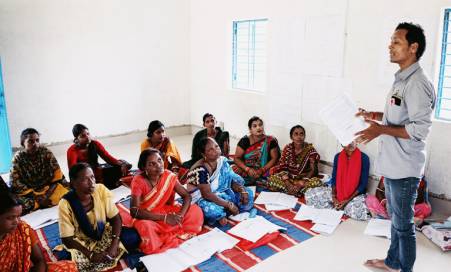
A teacher with some of our Second Chance learners at the Golabandha Cluster Center in Ghatagaon block of Odisha's Keonjhar district
Through the program, girls and women appear for their grade X exams through the National Institute of Open Boards (NIOS) (OR state open boards), after a year-long intervention at a Pratham run Second Chance centre. The program runs in two phases – a 4 month long Foundation Course, where the basics of core subjects – English, Maths, State Language etc are taught, following which a learner enters the Main Course, where topics and subjects specific to the boards are rigorously prepared.
Over the last decade Second Chance Program has reached more than 40,000 girls and women, across 9 states, who had dropped out of the formal education system.
Who joins the program and why?
As of 2022, Second Chance program runs in 9 states, reaching ~4,000 learners (predominantly females) annually.
In the beginning of every academic year, a team of Pratham facilitators (teachers) and a Block leader do a recce of surrounding villages to find dropouts interested in resuming their education. This takes multiple visits and negotiations as the team tackles the hesitation the girls and women have about their own abilities, persuading family members who hesitate to let women step out of their domestic duties while creating awareness about the open schooling system.
In 2021, ~90% of the learners who were mobilised were females, and 44% of these learners were Std IX dropouts; followed by 32% who dropped out after completing Std VIII. Over the years, the reasons shared by these learners for dropping out of school have remained largely similar – in 2021; financial constraints forced 1 in 4 learners to drop out; while 1 in 5 learners dropped out because they had failed in their respective grades, post which they decided not to return to school. ~1 in 5 learners dropped out of school due to family constraints, or additional family responsibilities caused by events such as death of a family member, illness etc.
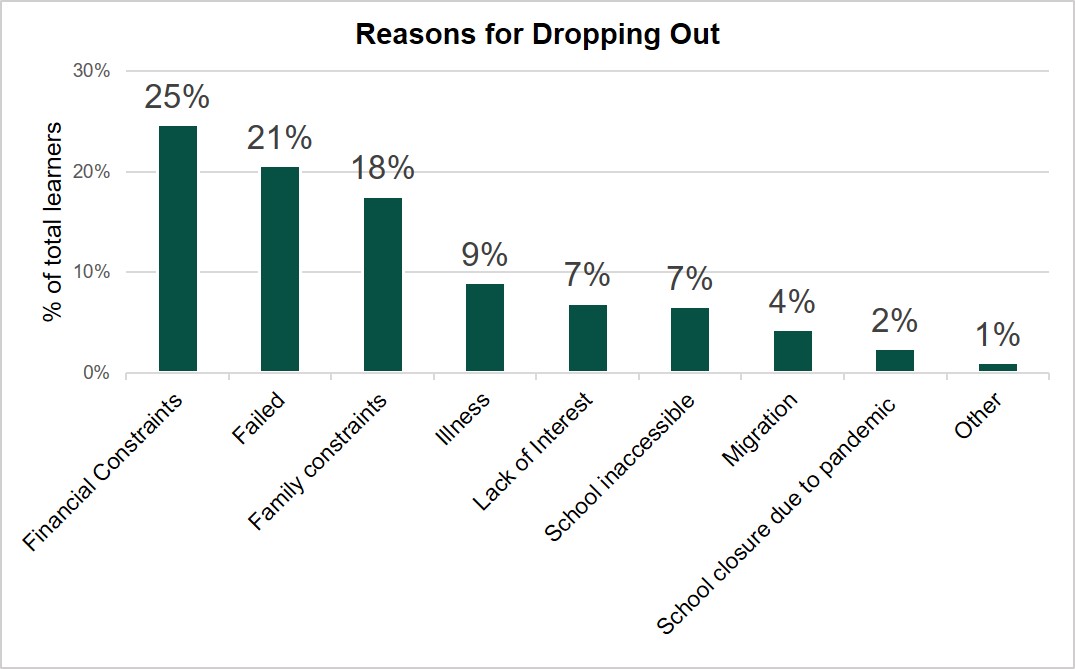
Source : Measurement, Monitoring and Evaluation (MME) team, Pratham, 2021
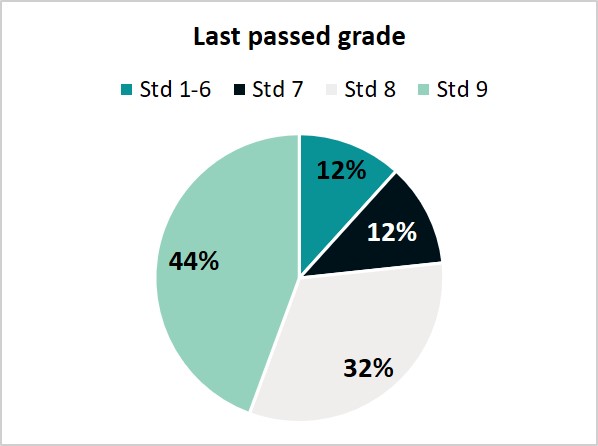
Learning gap (in years), 2021
Source : MME team, Pratham, 2021
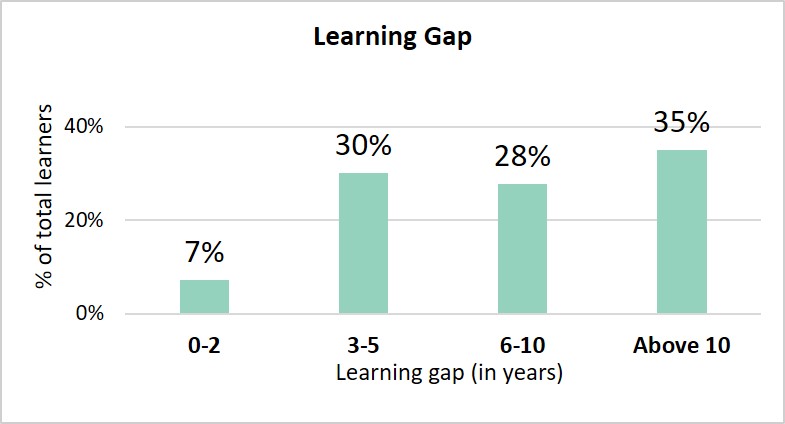
Last passed grade, 2021
Learners joining the program have a significant learning gap. In 2021, 44% of these learners were Std IX dropouts; followed by 32% who dropped out after completing Std VIII. The learning gap among mobilised learners was large – 35% of them last attended school at least 10 years ago, followed by 30% who attended school 3-5 years ago.
Tailoring teaching learning techniques for dropouts
In the first few months of the program, Pratham facilitators work on building the confidence of these women, and of breaking down the fear associated with Board Exams. “We break down the journey and the process of reappearing for Board Exams, for anyone who enrols in the program. We don’t start teaching from a textbook immediately – rather we assess what they know, and start from there,” says Vandana Dhotre, centre-in-charge of Pune, who has been associated with the program since 2013.
In the initial few weeks, strengths and weaknesses of each learner are assessed through a quick ‘pre-test’. The learners are grouped according to their learning levels, and a group leader is assigned in each group. This process helps the learners feel supported, and makes the process of learning less daunting.
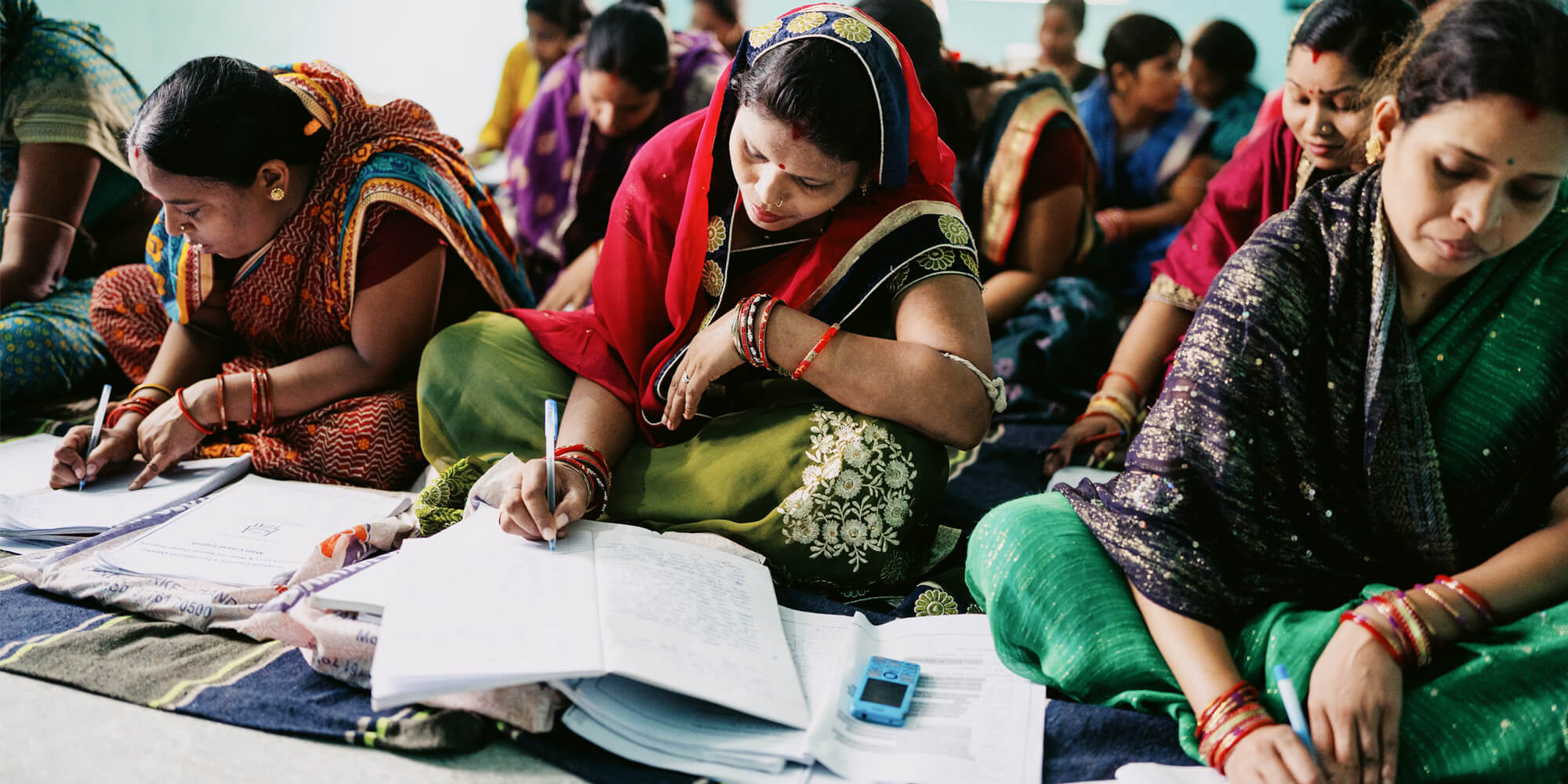
Women attending classes at the Hub Center in Ranpur block of Odisha's Nayagarh district
Achieving regular attendance in a Second Chance classroom can be challenging.
44% of the Second Chance cohort in the year 2021-22 were employed in various activities such as agriculture, assisting in their family’s business, or engaged in daily wage labour. Even those who reported being ‘unemployed’ (56%), were likely to be engaged in household and care duties, making it difficult for them to attend regular classes. Keeping these constraints in mind, the team has introduced ‘time management’ as a concept in the classroom, where learners are taught to draw up a study schedule for themselves.
“One of our learners was a sole earning member for her family, and had her own tiffin service, so she would find it difficult to attend regular 4 hour classes. Our facilitators visited her and understood her business timings. We suggested that she attend classes for 2 hours instead of 4. We even offered to shift class timings for her. She became really interested once she started attending classes regularly, now she has adjusted her business according to the class schedule”, says Vandana Dhotre, centre-in-charge at Pune.
Outcomes
The program has consistently demonstrated high passing rates over the years – 81% of all learners who appeared for the board exam in the academic year 2021-22 passed the exam. The Covid years 2019-20 and 2020-21 saw an increase of almost 10% points in the proportion of learners passing the board exam, due to NIOS and state open boards across the country removing or relaxing their passing criteria. The *average passing rate across all years, even without taking these two outlier years into account remains as high as 82%.
Percentage of learners who pass the board exam, continues to remain consistent
% of total learners appearing for the board exam in an academic year, who pass the exam
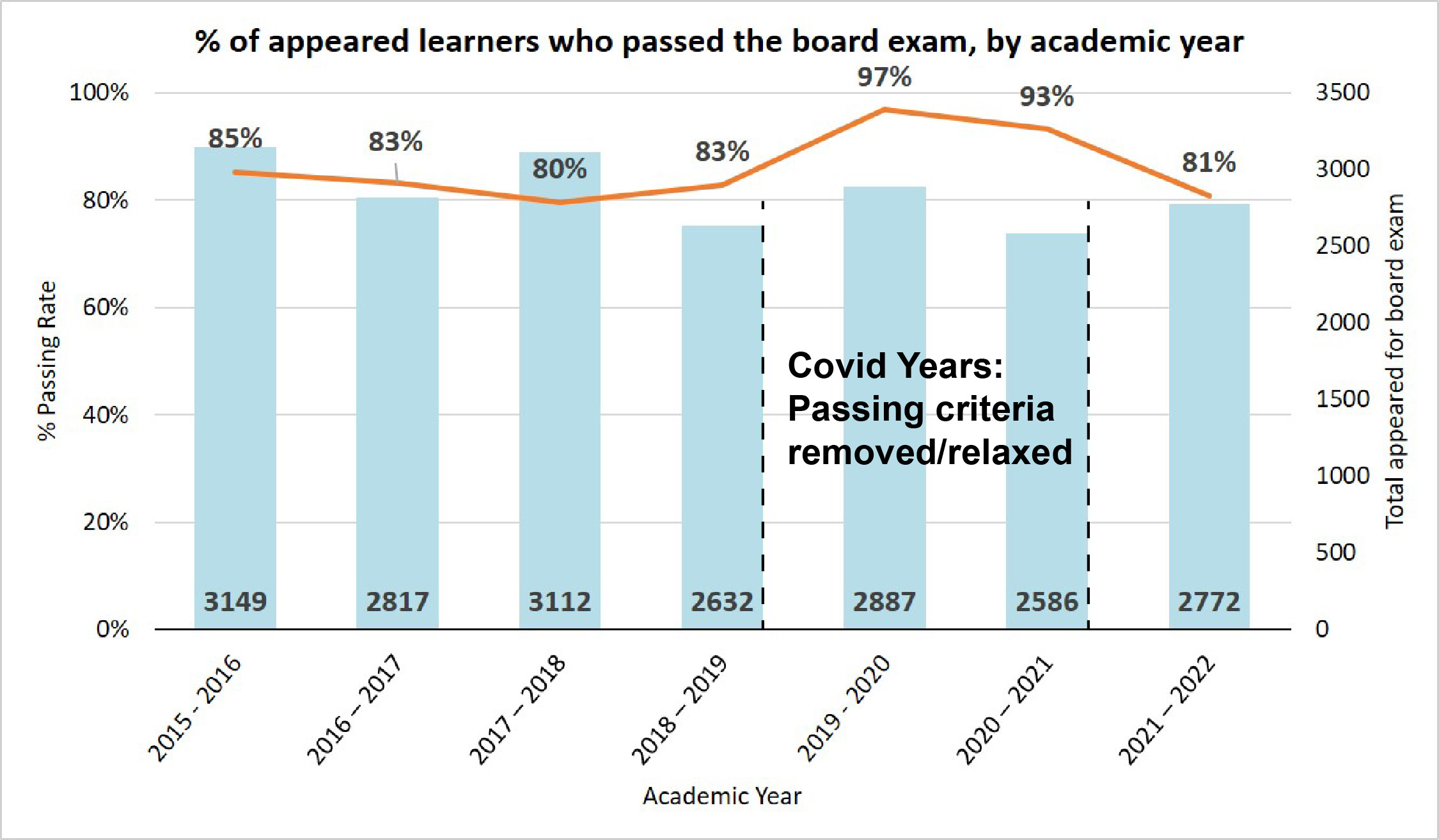
Source : MME team of Pratham
*Average passing rate across all years has been calculated without considering the outlier academic years 2019-20 and 2020-21
Why dropouts still continue
As per the data collected by the MME team of Pratham, in the academic year 2021-22, 1,144 learners dropped out of the Second Chance program, even before they were formally enrolled. To be enrolled in the program, the learners had to attend introductory classes and complete a baseline assessment of their abilities (called a Pre-Test). 421 learners dropped out after they were enrolled in the program.
One in three of learners who had dropped out during the entire course of the program did so due to family constraints, a term used to classify resistance from family members, or family responsibilities, that hinder the learner from continuing her studies in the program. ‘Need to work’ was another issue cited by 15% of the dropouts from the program. Learners who have financially unstable family backgrounds tend to pull out of the program if it affects their work and earnings. This is also linked to the issue of migration; migrants who engage in seasonal work outside their home state are unable to stay in the same location for the complete duration of the program, and hence drop out. Inability to pay fees is another reason cited by 14% of the learners. Although the team has introduced various strategies to ease the burden of fees (Eg:- Registration and Exam fees for NIOS are Rs 4250), complete fee waiver can often have a detrimental effect on learner motivation to continue their studies.
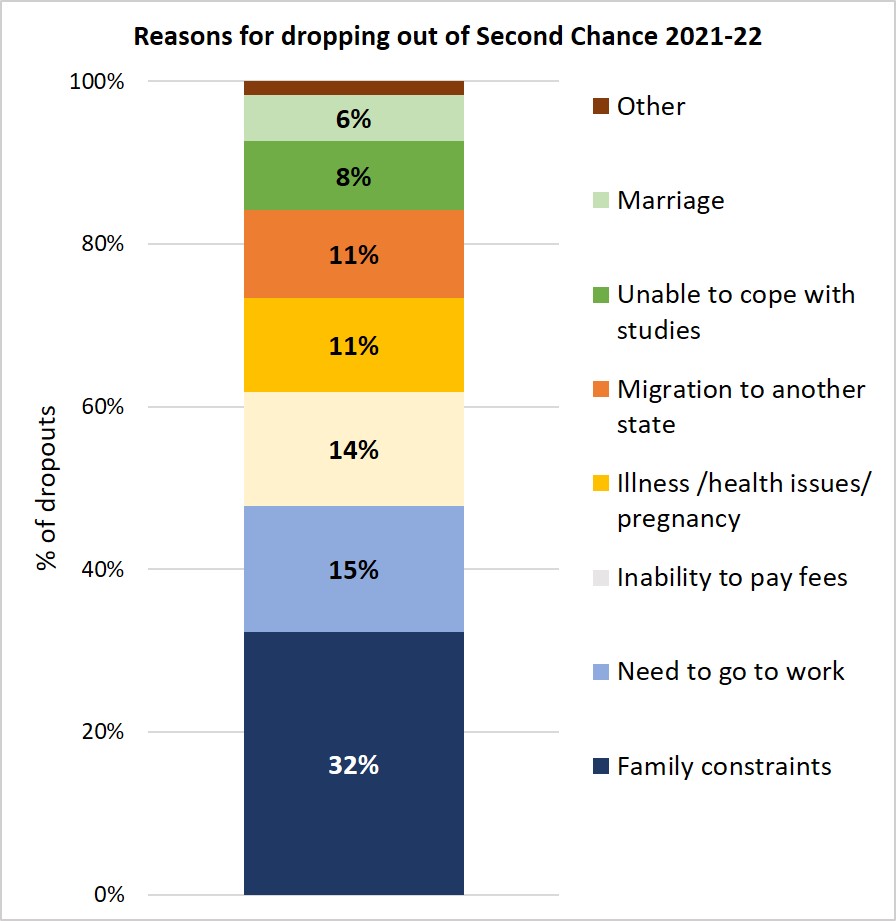
Source : MME team of Pratham, 2021
Often learners studying in the program get married causing them to move out of their hometown or encounter unsupportive in-laws.
“Sisters Leena and Suhana who had dropped out of school due to Covid, had joined our program this year. They were doing very well, and had even completed their registration for Board Exams. However, the elder of the two, Leena got engaged and her in-laws were not ready to let her study further. Despite multiple attempts to counsel her parents, she dropped out,” says Shalu Sharma, centre-in-charge of Jaipur block, Rajasthan.
Sometimes, attempts to counsel learners against dropping out do produce results. Aman Kumar, block leader of Second Chance Patna, shared a story about two learners in 2020, who were at the verge of dropping out of the program due to a death in the family, a few days before the board exam. The Bihar team visited the girls and counselled them against dropping out, reminding them of the hard work they’d put in to reach thus far. Both girls sat for their exams the next day, one clearing the exam in her first attempt. The other cleared it the next year, with help from the Bihar team.
Despite these challenges, retention rates have improved over the years
The push and pull of external factors on these women notwithstanding, the program leaders have done a remarkable job in retaining these women, from the time they are formally enrolled in a Second Chance ‘cluster centre’. The retention rate saw a slight dip of 5% points compared to the previous academic year in 2020, when the program had to quickly pivot to a completely online mode due Covid-19. The latest academic year 2021-22 saw the highest ever retention rate since the program inception – 87% of all learners who had enrolled in the program appeared for their board exams through open schooling.
Figure: Enrollment to Board Exams – onwards and upwards

Source : MME team of Pratham
Sanjivini Khope, 34, who dropped out of school in class 7 when she was married at 14, found herself dreaming of completing school again when she met Vandana Dhotre, centre-in-charge of Second Chance Pune. When met with resistance from her husband, who wanted her to restrict herself to household duties, she attended classes at the Second Chance centre in secret for 3 months. When her husband finally caught up with her, he was so impressed by her dedication that he bought her a smartphone to attend online classes with. Sanjivini is currently taking her board exams, and feels great joy in the fact that her husband and children now regard her with respect. With her newfound confidence, she has been able to navigate the public transport and travel on her own, something she was unable to do before. She credits Vandana and the Second Chance team for standing behind her in the face of all opposition.
“Because of them, I am no longer an unpadh (illiterate),” she says.
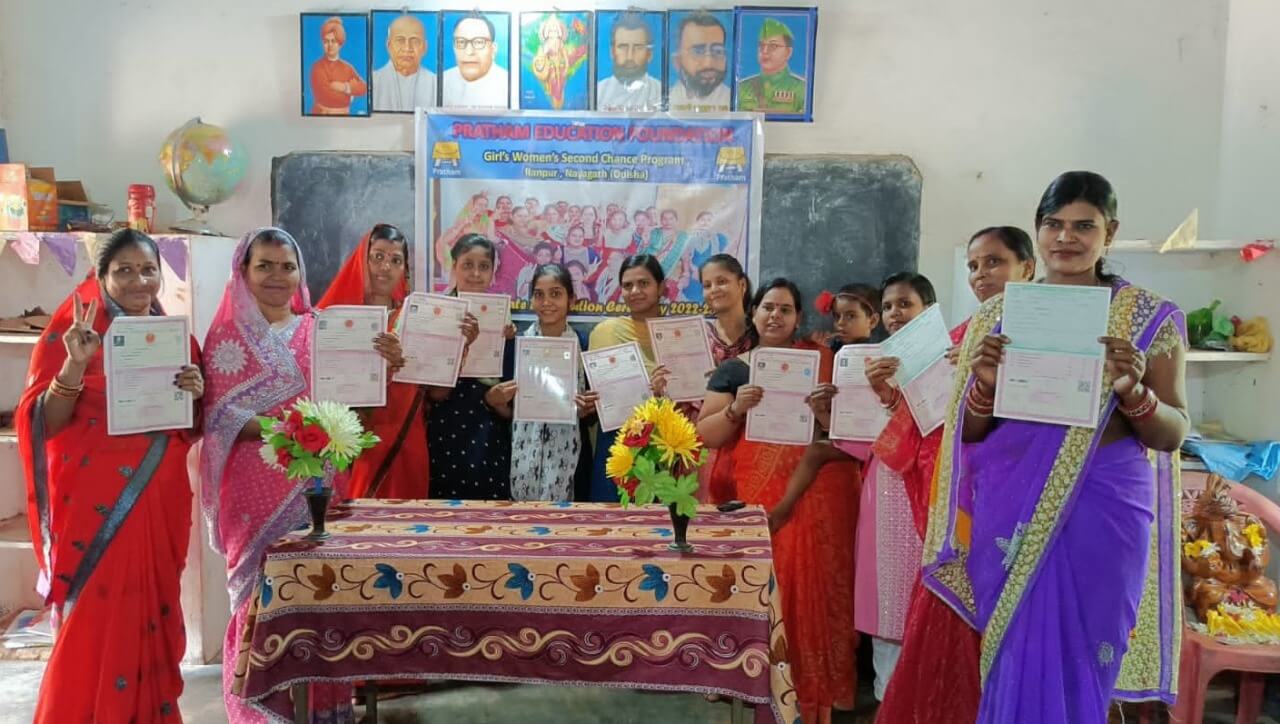
On its own, a board certificate is just that – a piece of paper, an academic milestone, that annually, millions of students in India achieve. The journey towards its attainment, for these women, is one of incremental change, both within themselves, and in the people around them. For many, it is a permission to dream and be ambitious, a privilege Indian women are rarely accorded.
-Tania Gupta
The author was a part of Pratham's Monitoring Measurement & Evaluation team from 2021 to 2024.
PS: This write-up has been published in its original form without any editing or alterations. Any grammatical errors, typos, or stylistic variations are preserved to maintain the authenticity of the author’s work. The views and opinions expressed here are those of the individual authors and do not reflect the views or positions of the organisation.
